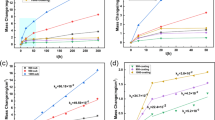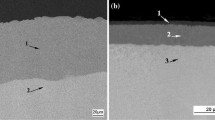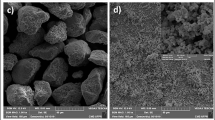Abstract
In this study, Ti-48Al-2Nb-2Cr (at.%) alloy was used as the substrate material. The coatings’ formation process was prepared by the slurry method. After the deposition of water-based slurry containing Al and Si powders on the substrate, the diffusion treatment has been carried out at 1,000 °C for 6 h in vacuum. The structure of the silicon-modified aluminide coating is as follows: (1) an outer layer consisting of a TiAl3 matrix and Ti7Al5Si12 grains dispersed within this matrix; (2) a middle layer composed of a TiAl3 matrix and columnar grains of Ti5Si3; and (3) an inner layer as TiAl2 phase. Mechanisms and reasons for the formation of such silicon-modified aluminide structure on the γ-TiAl alloy were discussed in this paper. The results of isothermal oxidation test of 1,000 °C/200 h showed that formation of Si-modified aluminide coating on γ-TiAl alloy by a slurry method can greatly improve its high temperature oxidation resistance.
Similar content being viewed by others
Avoid common mistakes on your manuscript.
Introduction
Gamma titanium aluminide alloy (γ-TiAl) has already been introduced as one of the most promising candidate materials for high temperature applications in the automotive, aerospace and power generation industries. Gamma-TiAl alloy has proven the suitability as a structural material for parts of automotive engines and has been successfully tested as low pressure turbine blades in aero engines [1]. The attractive properties of γ-TiAl are low density (3.7–3.9 g/cm3), high melting point, high strength and stiffness at elevated temperatures, good oxidation and creep resistance up to moderately high temperature and good dimensional stability [2–5]. Owing to these advantages, γ-TiAl alloys appear to have the potential to partly replace the heavy steels and nickel-based alloys presently used in gas turbines [1]. However, the oxidation resistance of γ-TiAl is inadequate at elevated temperatures above 800 °C associated with the formation of porous mixed TiO2 and Al2O3 scale instead of a protective scale of Al2O3 [6–8]. It is well known that the addition of some elements like Nb, Si, W, Ag, and Cr by suitable amounts improve the oxidation resistance of γ-TiAl, but further alloying often leads to deterioration of mechanical properties [8, 9]. In recent years, several studies on the surface modification have been performed to improve the oxidation resistance of γ-TiAl. Therefore, improvement of high temperature oxidation resistance of γ-TiAl alloys by surface treatment is thought to be more attractive.
The slurry method is a versatile and economical coating process widely used for obtaining aluminide protective coatings on turbine blades and vanes [10, 11]. The use of the slurry method has a series of distinctive advantages over aluminizing by the pack cementation process. These advantages are as follows: a shorter thermal cycle of coating application due to quick heating and cooling of the treated part; a possibility of local aluminizing; and a possibility of applying coatings to large-sized parts, for example, combustion chambers [10]. The slurry consists of element powders, such as Al, Al-Si, Al-Si-(Y, Ce, B) and so forth in a solution of binder [12]. The slurry can be applied by brush or conventional spray methods. When heated at a temperature of about 260–540 °C, the binder transforms to a glassy solid which bonds the metal powder particles to one another and to the substrate. It has been found that, when the slurry-coated substrate is heated to temperatures of about 1,000 °C, the aluminum powder melts and diffuses into the part to produce a protective aluminide on the surface of the substrate. Because the ceramic binder is stable at the processing temperatures, the element powders are firmly held against the substrate as diffusion proceeds. In fact, the formation of the aluminide layer in the slurry method is from liquid phase reactions of a metal-filled coating on the surface of the substrate [12, 13].
The aim of this study was to apply a Si-modified aluminide coating on a Ti-48Al-2Nb-2Cr (at.%) alloy, and to investigate the microstructure and oxidation resistance of the obtained coating. Based on the microstructural observation of the resultant coating, the probable mechanisms related to the reasons for the formation of such a silicon-modified aluminide coating are also discussed.
Materials and Methods
In this investigation, γ-TiAl substrate with a chemical composition of Ti-48Al-2Nb-2Cr (at.%) was used. Coupon specimens measuring 10 × 10 × 2 mm were cut from the ingot and all sliced specimens were polished to No. 1000 with SiC paper and cleaned ultrasonically in acetone. The water-based slurry available commercially under the trade name SermaLoy J (Sermatech International, USA), containing 12 wt% Si and Al (balance) powders, was used. In SermaLoy J slurry, aluminum and silicon powders are dispersed in a chromate binder. The substrate samples were covered by a single immersion in slurry, and then cured at an oven temperature of approximately 100 °C for at least 2 h. Figure 1 shows the SEM image of dry powders of SermaLoy J slurry on the substrate. In addition, Table 1 shows the EDS analysis of the selected points in Fig. 1. The covered samples were then vacuum-encapsulated in a quartz tube at a pressure less than 10−5 mbar. Then, the whole system consisting of the covered samples in the quartz tube was loaded into an alumina tube furnace. The furnace was heated to 320 °C and held at this temperature for 2 h until the binder transformed to a glassy solid, then the temperature was raised to a final temperature of 1,000 °C at a heating rate of 10 K/min and was held there for 6 h. The furnace was then cooled to room temperature at its natural rate by switching off the power supply.
In order to evaluate the oxidation resistance of the coated specimen, isothermal oxidation test was carried out in static air at 1,000 °C. The specimens were placed in a tube furnace oxidized at 1,000 °C for 200 h. The sample weights were measured to 0.0001 g only at the beginning and the end of the oxidation process.
Phase analysis of the obtained coating was performed with x-ray diffraction analysis using Cu-Kα1 source radiation and a Ni-filter. In addition, the cross-section of the coating was analyzed by a field emission scanning electron microscope equipped with an energy-dispersive x-ray spectroscopy detector and back-scattered electron imaging capabilities.
Results
Figure 2 shows back-scattered electron image of the Si-modified aluminide coating formed on the Ti-48Al-2Nb-2Cr (at.%) alloy. A triple-zone structure can be observed in the resultant coating on the γ-TiAl alloy by the slurry method. The results of the chemical composition analysis of the selected points in Fig. 2 have been presented in Table 2.
The cross-section of the coating (presented in Fig. 2) shows that the Si-modified aluminide coating on the γ-TiAl alloy is about 50 μm thick, dense, and very much adherent to the substrate. No pores or cracks can be seen within the coating.
Results related to XRD phase analysis of the coating formed on the γ-TiAl [Ti-48Al-2Nb-2Cr (at.%)] sample are shown in Fig. 3. In order to determine the phases of the above-mentioned coating, XRD phase analysis was carried out in two steps. First, an XRD phase analysis was performed on the surface layer of the coating formed on the γ-TiAl sample, the result of which is shown in Fig. 3(a). Then, by removing 30 μm from the initial surface layer of the coating through grinding, another XRD phase analysis was done on the new surface, the result of which is presented in Fig. 3(b). According to the results obtained from the cross-section and EDS analysis of different points, as well as the XRD analyses, it can be concluded that the coating formed on the γ-TiAl substrate by the slurry method had a distinct triple-zone structure which included:
-
An outer layer consisting of a TiAl3 matrix and dispersed Si-enriched grains within this matrix. According to XRD phase analysis, these dispersed Si-enriched grains were in fact ternary compounds of Ti7Al5Si12.
-
A middle layer composed of a TiAl3 matrix (similar to the outer layer) and Si-enriched compact columnar particles. According to XRD phase analysis, these compact particles were titanium silicide (Ti5Si3) phase.
-
An inner layer exactly beneath the middle layer as TiAl2 phase. However, it was observed that the limited number of Si-enriched lamella has continued to this inner layer.
Results related to isothermal oxidation test at 1,000 °C and duration of 200 h for γ-TiAl alloy used in this study are demonstrated in Table 3. As can be observed in the results of the oxidation, formation of Si-modified aluminide coating by the slurry method significantly improved the high-temperature oxidation resistance of the γ-TiAl alloy used in this investigation. In fact, the increase in the mass of γ-TiAl sample coated by the slurry method after oxidation at 1,000 °C for the duration of 200 h was considerably less than that of the uncoated γ-TiAl sample. The above-mentioned result demonstated that formation of Si-modified aluminide coating on the γ-TiAl alloy can greatly improve its high-temperature oxidation resistance.
Discussion
In this slurry method, after the formation of the desired slurry on the substrate and after the diffusion treatment at 1,000 °C, first, the Al powder available in the slurry was melted and then the Si powder available in the slurry was dissolved into the molten Al. Consequently, different phases were formed within the coating by liquid phase diffusion into the substrate as a result of which the Al available in the liquid reacted with the titanium and formed TiAl3. Also, by diffusion of the liquid into the substrate, Si present in the liquid reacted with the substrate’s elements and formed the ternary compounds of Ti7Al5Si12. Furthermore, binary compounds of titanium silicide (Ti5Si3) were formed as the dominant products in different layers of the coating.
Trends in the formation of the Ti-Si binary compound of Ti5Si3 can be interpreted thermodynamically. According to Xiong et al. [14], Si had a great affinity with Ti. In fact, the Ti-Si binary compound of Ti5Si3 can be formed by the following reaction at a high temperature:
At 780 °C, the ΔG value for the formation of Ti5Si3 consuming per mole of TiAl is −51.5 kJ/mol, implying that, at high temperatures, Si can react with TiAl to form Ti5Si3 binary compounds [15]. During the liquid-phase diffusion of molten Al-Si alloy in the TiAl, besides the Ti-Si binary compounds of Ti5Si3, the Ti-Al-Si ternary compounds of Ti7Al5Si12 as the predominant reaction product have also been formed in modified aluminide coating. The overall reaction can be described qualitatively as follows:
In general, the resultant Si-modified aluminide coating has been obtained by the liquid-phase of simultaneous aluminizing and siliconizing processes.
By closely examining the results related to the EDS analysis of different points of the coating formed on the surface of Ti-48Al-2Nb-2Cr (at.%) alloy used in this study, it can be observed that every area of the coating with Si-enriched compounds had a considerably higher concentration of the Cr element than the matrix surrounding that compound. In Fig. 2, at point 1, Cr concentration was very low; however, at point 2, which was related to the triple compound of Si-enriched Ti7Al5Si12, Cr concentration of this point was significantly higher and exceeded the Cr concentration in the substrate itself. This phenomenon was also observed at point 4 in Fig. 2 which was related to the Ti5Si3 phase. In fact, according to the results of this study, it can be expressed that, in the coating formed on the surface of Ti-48Al-2Nb-2Cr (at.%) alloy, the Cr concentration in Si-enriched phases was much higher than the points around those phases, which was not true for the Nb element. This point indicates that, among Cr and Nb alloy elements, Cr had a higher tendency to move towards the Si-enriched compounds, and therefore that Cr is a strong silicide former.
Conclusions
-
1.
The obtained Si-modified aluminide coating on the γ-TiAl [Ti-48Al-2Nb-2Cr (at.%)] alloy by the slurry method is about 50 μm thick, dense, very much adherent to the substrate and without any pores or cracks within the coating.
-
2.
The coating formed on the γ-TiAl substrate by the slurry method had a distinct triple-zone structure which included: (1) an outer layer consisting of a TiAl3 matrix and ternary compounds of Ti7Al5Si12 grains dispersed within this matrix; (2) a middle layer composed of a TiAl3 matrix and titanium silicide Ti5Si3, which formed columnar grains; and (3) an inner layer as TiAl2 phase.
-
3.
The resultant structure of the Si-modified aluminide coating has been obtained by the liquid-phase of simultaneous aluminizing and siliconizing processes.
-
4.
Among Cr and Nb as alloying elements in the γ-TiAl alloy used in this study, Cr had a higher tendency to move towards the Si-enriched compounds and therefore Cr is a strong silicide former.
-
5.
The formation of Si-modified aluminide coating on γ-TiAl alloy can greatly improve its high-temperature oxidation resistance.
References
M. Frohlich, R. Braun, C. Leyens, Oxidation resistant coatings in combination with thermal barrier coatings on γ-TiAl alloys for high temperature applications. Surface and Coatings Technology 201, 3911–3912 (2006)
M. Mirjalili, M. Soltanieh, K. Matsuura, M. Ohno, On the kinetics of TiAl3 intermetallic layer formation in the titanium and aluminum diffusion couple. Intermetallics 32, 297–298 (2013)
F. Appel, J.D.H. Paul, M. Oehring, Gamma titanium aluminide alloys. Science and technology (Wiley-VCH Verlag & Co. KGaA, Weinheim, 2011), pp. 1–4
H. Clemens, H. Kestler, Processing and Applications of Intermetallic γ-TiAl-Based Alloys. Advanced Engineering Materials 2, 551–570 (2000)
W.E. Voice, M. Hendersonb, E.F.J. Shelton, X. Wu, Gamma titanium aluminide, TNB. Intermetallics 13, 959–964 (2005)
R. Braun, M. Fröhlich, W. Braue, C. Leyens, Oxidation behavior of gamma titanium aluminides with EB-PVD thermal barrier coatings exposed to air at 900°C. Surface and Coatings Technology 202, 676–678 (2007)
M. Yoshihara, Y.W. Kim, Oxidation behavior of gamma alloys designed for high temperature applications. Intermetallics 13, 952–958 (2005)
S. Sarkar, S. Datta, S. Das, D. Basu, Oxidation protection of gamma-titanium aluminide using glass-ceramic coatings. Surface and Coatings Technology 203, 1797–1798 (2009)
J.W. Fergus, Review of the effect of alloy composition on the growth rates of scales formed during oxidation of gamma titanium aluminide alloys. Materials Science and Engineering A 338, 108–125 (2002)
Y. Tamarin, Protective coatings for turbine blades (ASM International, Ohio, 2002), pp. 32–35
T.V. Levchenko, V.I. Moroz, L.P. Buiyanova, Protective coatings on metals. Naukova Dumka 4, 158–164 (1971)
Mcmordie B. G., Kircher T. A. (1997). Platinum enriched, silicon-modified corrosion resistant aluminide coating. US Patent 05650235
Deadmore D. L., Young S. G. (1980). Method of protecting a surface with a silicon-slurry/aluminide coating. US Patent 4310574A
H.P. Xiong, W. Mao, Y.H. Xie, W.L. Ma, Y.F. Chen, X.H. Li, J.P. Li, Y.Y. Cheng, Liquid-phase siliconizing by Al-Si alloys at the surface of a TiAl-based alloy and improvement in oxidation resistance. Acta Materialia 52, 2605–2620 (2004)
C.G. Wan, H.P. Xiong, Z.F. Zhou, Joining of Si3N4/Si3N4 with CuNiTiB paste brazing filler metals and interfacial reactions of joints. Journal of Materials Science 4(12), 3013–3019 (1999)
Author information
Authors and Affiliations
Corresponding author
Rights and permissions
About this article
Cite this article
Nouri, S., Mirdamadi, S., Rastegari, S. et al. Microstructural Investigation of Si-Modified Aluminide Coating Formed on γ-TiAl Alloy by the Slurry Method. Metallogr. Microstruct. Anal. 4, 109–113 (2015). https://doi.org/10.1007/s13632-015-0190-8
Received:
Revised:
Accepted:
Published:
Issue Date:
DOI: https://doi.org/10.1007/s13632-015-0190-8







